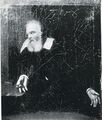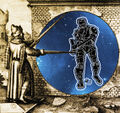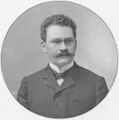Template:Selected anniversaries/June 22: Difference between revisions
No edit summary |
No edit summary |
||
| (2 intermediate revisions by the same user not shown) | |||
| Line 7: | Line 7: | ||
||1792: James Beaumont Neilson born ... engineer and businessman ... iron smelting. Pic. | ||1792: James Beaumont Neilson born ... engineer and businessman ... iron smelting. Pic. | ||
||1837: Paul Morphy born ... chess player. | ||1837: Paul Morphy born ... chess player. | ||
||1837: Paul Gustav Heinrich Bachmann born ... mathematician. His major works include ''Analytische Zahlentheorie'', a work on analytic number theory in which Big O notation was first introduced. Pic. | ||1837: Paul Gustav Heinrich Bachmann born ... mathematician. His major works include ''Analytische Zahlentheorie'', a work on analytic number theory in which Big O notation was first introduced. Pic. | ||
||1848: William Macewen dies ... surgeon and neuroscientist. Pic. | |||
||1860: Mario Pieri born ... mathematician who is known for his work on foundations of geometry. Pic. | ||1860: Mario Pieri born ... mathematician who is known for his work on foundations of geometry. Pic. | ||
File:Hermann Minkowski.jpg|link=Hermann Minkowski (nonfiction)|1864: Mathematician and academic [[Hermann Minkowski (nonfiction)|Hermann Minkowski]] born. He will show that Albert Einstein's special theory of relativity can be understood geometrically as a theory of four-dimensional space–time, since known as the "Minkowski spacetime". | File:Hermann Minkowski.jpg|link=Hermann Minkowski (nonfiction)|1864: Mathematician and academic [[Hermann Minkowski (nonfiction)|Hermann Minkowski]] born. He will show that Albert Einstein's special theory of relativity can be understood geometrically as a theory of four-dimensional space–time, since known as the "Minkowski spacetime". | ||
||1874: Howard Staunton dies ... chess player. | ||1874: Howard Staunton dies ... chess player. | ||
| Line 50: | Line 48: | ||
||1940: Daniel Quillen born ... mathematician. He is known for being the "prime architect" of higher algebraic K-theory, for which he was awarded the Cole Prize in 1975 and the Fields Medal in 1978. Pic: https://ronsview.org/2011/05/10/daniel-quillen/ | ||1940: Daniel Quillen born ... mathematician. He is known for being the "prime architect" of higher algebraic K-theory, for which he was awarded the Cole Prize in 1975 and the Fields Medal in 1978. Pic: https://ronsview.org/2011/05/10/daniel-quillen/ | ||
||1953: Mauro Francaviglia born ... mathematician and academic. Pic search: https://www.google.com/search?q=mauro+francaviglia | |||
||1953: | ||1953: Hollow Nickle case: a newspaper boy (fourteen-year-old Jimmy Bozart), collecting for the Brooklyn Eagle, at an apartment building at 3403 Foster Avenue in the New York City borough of Brooklyn, was paid with a nickel (U.S. five-cent piece) that felt too light to him. When he dropped it on the ground, it popped open, revealing that it contained microfilm. The microfilm contained a series of numbers. He told the daughter of a New York City Police Department officer, and that officer told a detective who in two days told an FBI agent about the strange nickel. Pic. | ||
||1954: Karl Taylor Compton dies ... physicist and president of the Massachusetts Institute of Technology (MIT) from 1930 to 1948. Pic. | ||1954: Karl Taylor Compton dies ... physicist and president of the Massachusetts Institute of Technology (MIT) from 1930 to 1948. Pic. | ||
Latest revision as of 18:25, 6 February 2022
1633: The Holy Office in Rome forces Galileo Galilei to recant his view that the Sun, not the Earth, is the center of the Universe in the form he presented it in, after heated controversy.
1633: Rogue mathematician and alleged supervillain taunts Galileo Galilei for recanting, daring Galileo to "tell it like it is, and let them burn you for it."
1864: Mathematician and academic Hermann Minkowski born. He will show that Albert Einstein's special theory of relativity can be understood geometrically as a theory of four-dimensional space–time, since known as the "Minkowski spacetime".
1910: Engineer, inventor, and pioneering computer scientist Konrad Zuse born. He will invent the Z3, the world's first working programmable, fully automatic computer.
1977: Mathematician Gabriel Sudan dies. He discovered the Sudan function, an important example in the theory of computation, similar to the Ackermann function.




